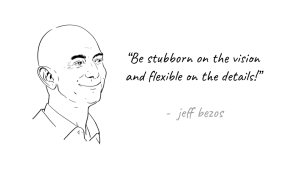How to create a great Product Goal in Scrum using the Product Goal Canvas

The 2020 Scrum Guide introduces the concept of a Product Goal to provide focus for the Scrum Team toward a larger valuable objective. Each Sprint should bring the product closer to the overall Product Goal.
Since we already shared our view on the most important changes in the Scrum Guide, we want to share with you how to systematically develop a great Product Goal using the Product Goal Canvas in this article. This is a simple, yet powerful tool that helps a Scrum Team think about the most important aspects of their product, capture them on one canvas, and communicate the Product Goal towards their stakeholders. So let’s dive in.
The Product Goal Canvas!
Every Product Goal should clearly answer the following questions:
- Which customer segments are we serving?
- What is the problem we intend to solve?
- How does our solution look like and how does it differentiate itself from competing offerings?
- How does the product create value for our own business?
The bottom part of the Product Goal Canvas consists of 4 building blocks that help you systematically go through these questions. It also includes a few guiding questions to dive deeper into each building block. Let’s explore them one by one.
Customer Segments
Every product team and their stakeholders need to be aligned 100% on which customers segments they want to serve. Tools like the Empathy Map Canvas or concepts like Personas can be very helpful in order to define the customer segments and detail them. In many cases, a product serves more than one customer segment. It is OK to include multiple customer segments in your Product Goal Canvas.
Problem
Once a team has clarity on the customer segment they want to serve, they need to align on the problem they intend to solve. A problem could be a specific job-to-be-done (a concept popularized by Clayton Christensen), customer pains, and/or gains. Personally, I really like the Value Proposition Canvas (from Strategyzer) as a thinking tool to dive deeper into both the Problem and the Solution.
Solution
This building block of the Product Goal Canvas summarizes the Solution the team wants to implement. The team needs to state what the product or service is going to be without going too deep into the details. The unique value proposition of the product e.g. pain relievers or gain creators can and potentially should be mentioned.
Similar to the previous building block, the solution can also be generated by using the Value Proposition Canvas from Strategyzer. A process that can help you systematically get from Problem to Solution is Design Thinking. With its five steps (Empathize, Define, Ideate, Prototype, and Test) it guides a team to achieve Problem-Solution-Fit which is necessary before moving into implementation.
Business Value
This last building block captures the desired outcomes for the organization itself. Why are we as an organization building this product? The first three building blocks are all centred around our customers and their needs. This last one is about us. Is this product going to help us advance our mission? Does it deliver toward our strategy? How will measure its success? Will it contribute revenue directly or indirectly?
A great Product Owner needs to answer these questions. The creation of the Product Goal is the right place and the right point in time to do this. Teams that use OKRs can connect their initiative to their organization’s OKRs in this building block of the Product Goal Canvas.
Product Goal
Once all four building blocks at the bottom of the Product Goal Canvas have been filled, one can move to articulate the Product Goal. There are many ways to do this. One very simple way is the following sentence structure:
For ❮Customer Segment❯ with ❮Problem❯ we deliver ❮Solution❯. Through this we achieve ❮Business Value❯.
This can result in Product Goals that are longer than most product slogans. This is fine. Bear in mind that the Product Goal is something that we communicate internally. It is not meant to be for our external customers. The Product Goal is created to guide the team working on the product and provide them purpose and focus. The Product Goal also intends to align the team and its most important internal stakeholders. If they are an inch apart on the Product Goal, they will end up miles apart on the product itself. Early alignment is key.
One more thing… every Product Goal needs to be articulated on a certain flight level. You don’t want to be too abstract as that does not result in real alignment. You also don’t want to be too detailed as that takes away flexibility i.e. agility. One quote from Jeff Bezos (Founder & CEO of Amazon) has helped me a lot in finding the right balance.
“Be stubborn on the vision and flexible on the details!”
With that being said, enjoy using the Product Goal Canvas. We hope it will play a small role in building better products to make society more productive, more humane, and more sustainable.
You can download the Product Goal Canvas here). If you want to learn more about how to use the Product Goal Canvas and other concepts to build great products, join our Certified Product Owner Trainings.
Product Owner Online Course

Improve your skills as a product owner!
Learn how to systematically create a product backlog and build a comprehensive product vision that benefits your customers and your business. Real-world examples from various industries included!
Get the online course
